Full Text Searchable PDF User Manual
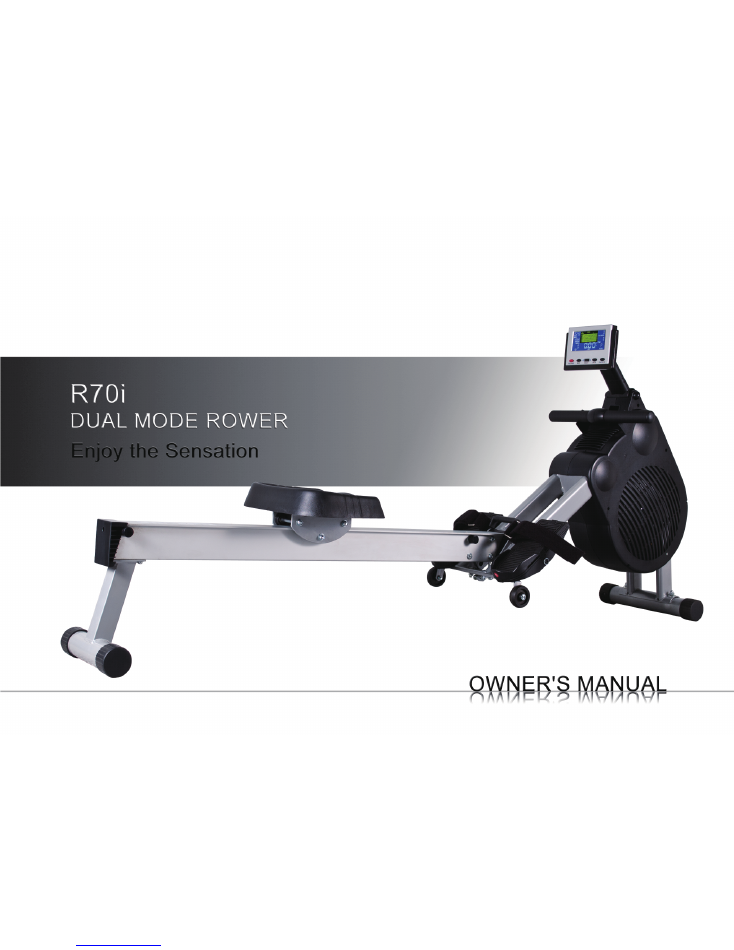

INTRODUCTION
--------------------------------------------------------
1
TABLE OF CONTENTS
------------------------------------------------
1
BENEFITS OF EXERCISE
--------------------------------------------
2
MEDICAL/SAFETY NOTICE
------------------------------------------
2
CARE AND MAINTENANCE
------------------------------------------
2
FEATURES OF THE AIR MAGNETIC ROWER
-------------------
3
------------------------------------------
TRAINING TIPS
4
------------------------------------------
TRAINING GUIDELINES
4-6
SETTING UP YOUR ROWER
-----------------------------------------
7-8
CORRECT ROWING GUIDE
------------------------------------------
9-10
STRETCHING
------------------------------------------------------------
11
Congratulations!
Save valuable exercise time in the long run.
Exercise safely and more effectively.
Learn proper techniques.
Be able to better define your fitness goals.
INTRODUCTION
TABLE OF CONTENTS
Welcome to the world of the Air Magnetic Rower. The
R70i Dual Mode Rower is one of the finest and most
comprehensive rowing machines available. We know
as we have been designing rowing machines for over
a decade.
By choosing Air Magnetic Rower, you have made a
decision that will improve the health and fitness and
well being for you and your family. Being fit and
healthy will improve your energy levels and your qual-
ity of life.
Cardiovascular training is vital for all ages and the Air
Magnetic Rower provides a more effective workout,
producing better results and will encourage you to
reach your fitness goals and maintain the body you
have always wanted.
All you need to do is to spend 15 to 30 minutes three
times a week to start seeing the benefits of a regular
exercise program on the Air Magnetic Rower.
We want you to enjoy the full benefits of your exercise
program and so we recommend that you read this
manual thoroughly and by doing so you will:
1
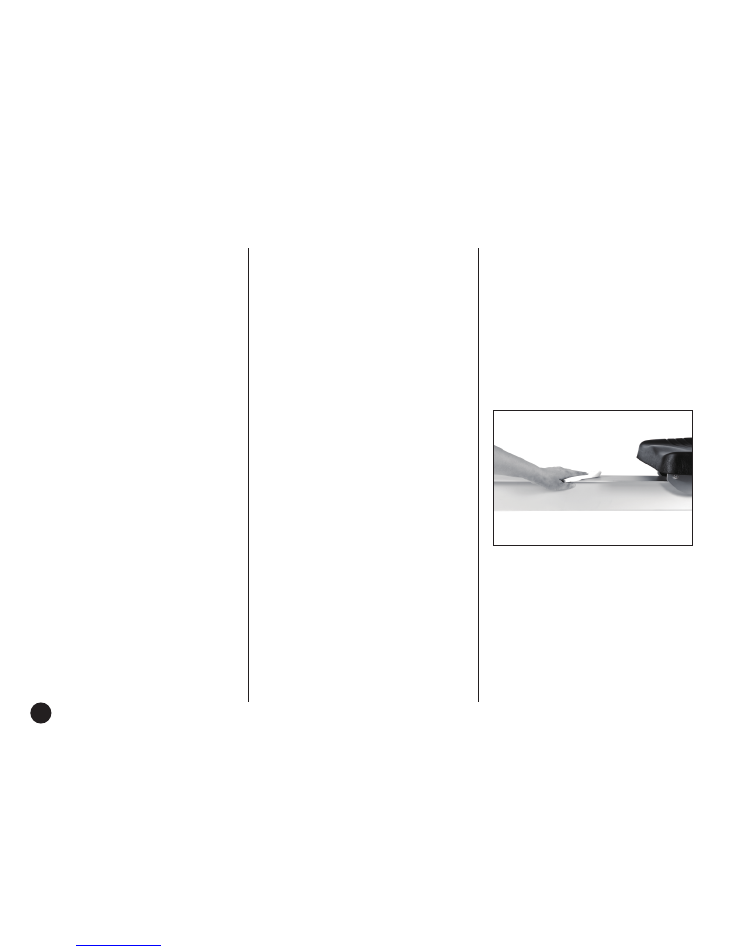
MEDICAL / SAFETY NOTICE
BENEFITS OF EXERCISE
CARE AND MAINTENANCE
Regular exercise improves both the quality and
quantity of life.
The benefits of regular participation in a well-
balanced fitness program include:
1. Weight loss
2. Improved body shape and definition
3. Increased muscle mass, strength, endurance,
power and definition
4. Enhanced flexibility
5. Increased metabolism
6. Injury prevention
7. Improved self-esteem
8. Improved aerobic fitness
9. Improved coordination and agility
A regular exercise program will improve the quality of
your life, give you more energy and slow down the
aging process.
Fifteen to thirty minutes, three times a week, or only
one and a half hours a week is a small price to pay
for huge benefits of a regular exercise program.
Failure to read and follow the safety instructions
below and in the Owner’s Manual may result in
serious injury or even death.
1. Read the Owner’s manual and all safety instruc-
tions thoroughly and familiarize yourself with the Air
Magnetic Rower before using it.
2. Before beginning any exercise program, consult
your physician. He or she can help evaluate your
present fitness level and determine the exercise
program that is the most appropriate for your age
and physical condition.
3. If you experience any pain or tightness in your
chest, irregular heartbeat, and shortness of breath,
faintness or unusual discomfort during exercising,
stop and consult a physician before continuing.
4. Adult supervision is required at all times when a
child is on or near the Rower.
5. Keep fingers and limbs, loose clothing and hair
away from moving parts.
6. All equipment should be checked for wear before
each use. Do not use this equipment unless all
moving parts are working correctly.
7. Care should be taken when getting on or off this
or any exercise equipment
8. Use only the accessory attachments recom-
mended by the manufacturer.
9. All equipment should be set up and operated on
solid, level surfaces.
Your Rower is made of the highest quality materials.
It is so important that you take care of your Rower
on a regular basis.
1. Your Air Magnetic Rower is for indoor use only
and should not be used or stored in damp areas.
Wipe all perspiration from your Air Magnetic Rower
after each use.
2. The Air Magnetic Rower should be dusted and
cleaned on a regular basis to stop build-up of dust.
Use Windex or an alcohol-based cleaner on a clean
cloth on a regular basis. Do not use any abrasive
cleaners, as this will damage the surface.
3. To ensure that the seat runs smoothly the roller
track of the monorail and the rollers need special
cleaning with oil based furniture polish.
4. Regularly check tightness of nuts, bolts and pins,
etc.
2

FEATURES OF THE AIR
MAGNETIC ROWER
CHEST BAND TRANSMITTER
(OPTIONAL)
The Air Magnetic Rower allows you all the advan-
tages of a full sized rowing machine in a compact,
folding design.
The Air Magnetic Rower provides smooth and
variable exercise capabilities with:
Full range Resistance Control
Rotating Foot Pedals
Ergonomic rowing action
Full Electronics package.
Strong stable frame.
Chest Band Pulse Transmitter (Optional)
DESIGNS NOTE.
The return spring on this Air Mag-
netic Rower has been designed with the lights
possible force. There is more than sufficient spring
tension to recoil the polyester strap regardless of the
return speed of the handle to the start position.
The reason for the light return spring is to give the
user an improved level of exercise by increasing the
benefit to the hamstring group of muscles at the rear
of the thigh.
This muscle group is called upon when the user
moves the seat forward.
We have faithfully duplicated the “normal” rowing
action one would get when rowing on water where
the oar is not pulled forward.
HANDLEBAR
STABILIZER - FRONT
ADAPTOR
SOCKET
FOOT PEDAL
PIVOT LOCK BAR HANDLE
TRANSPORTATION WHEEL
ALUMINUM BEAM
COMPUTER
SEAT
PIVOT HANDLE
FOOT STRAP
SEAT CARRIAGE STOPPER
STABILIZER - REAR
STANDARD CAP
3

TRAINNING TIPS
TRAINING GUIDELINES
Rowing machines have been around for many
years and where perhaps one of the first
indoor exercise machines on the market.
Almost everyone knows how to row on one of
these machines and there is very little one can
do wrong. However, there are few pointers we
can give you to reduce strain on your back and
other joints and muscles. Rowing, more than
any other aerobic exercise, utilizes the back
muscles and the spine to transfer the pulling
force from the arms (holding the handle) to the
legs (providing most the pulling power).
To reduce exercisive strain on the back
muscles, spine, shoulders, arms and wrists we
strongly suggest taht you to keep your back
straight throughout the entire rowing action.
When moving forward to the start position
bend at the hips, don’t overreach (trying to
stretch forward too much) and keep your arms
straight. Pull the handle to your stomach, not
your chest and keep your elbows in at your
sides during the entire stroke with your wirists
straight.
EXERCISE
Exercise is one of the most important factors in the
overall health of an individual. Listed among its
benefits are:
Increased capacity for physical work(strength
endurance)
Increased cardiovascular (heart and arteries /
veins) and respiratory efficiency.
Decreased risk of coronary heart disease changes
in body metabolism, e.g. losing weight.
Delaying the physiological effects of age physi-
ological effects, e.g. reduction in stress, increase in
self-confidence, etc.
Your Rower’s unique design provides an excellent
opportunity for a high level of overall fitness.
Basic Components of Physical Fitness
There are four all-encompassing components of
physical fitness and we need to briefly define each
and clarify its role.
Strength
is the capacity of a muscle to exert a force
against resistance. Strength contributes to power
and speed and is of great importance to a majority of
sports people.
Muscular Endurance
is the capacity to exert a
force repeatedly over a period of time, e.g. it is the
capacity of your legs to carry you 0 km without stop-
ping.
Flexibility
is the range of motion about a joint.
Improving flexibility involves the stretching of
muscles and tendons to maintain or increase
suppleness, and provides increased resistance to
muscle injury or soreness.
Cardio-Respiratory Endurance
is the most
essential component of physical fitness. It is the
efficient functioning of the heart and lungs.
What to wear
Wear clothing that will not restrict your movement in
any way while exercising.
Cloths should be light enough to allow the body to
cool. Excessive clothing that causes you to perspire
more than you normally would while exercising,
gives you no advantage. The extra weight you lose
is body fluid and will be replaced with the next glass
of water you drink.
It is advisable to wear a pair of gym or running shoes
or “sneakers”.
Breathing During Exercise
Do not hold your breath while exercising. Breathe
normally as much as possible. Remember, breath-
ing involves the intake and distribution of oxygen,
which feeds the working muscles.
Rest Periods
Once you start your exercise program, you should
continue through to the end. Do not break off
halfway through and then restart at the same place
later on without going through the warm-up stage
again.
The rest period required between strength training
exercises may vary from person to person. This will
depend mostly on your level of fitness and the
program you have chosen. Rest between exercises
by all means. Most people manage with half minute
to one-minute rest periods.
4
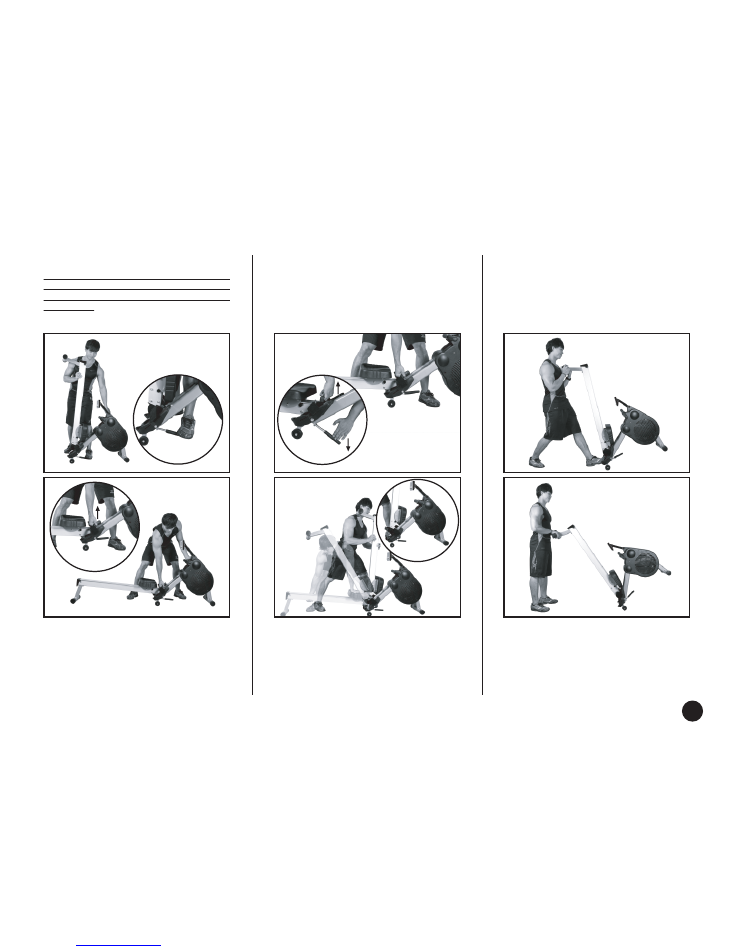
IMPORTANT: Clear a workout area 1 x 2.5 Meters before setting-up your Air Magnetic Rower. Ensure the floor is solid and level.
Transportation Storage
Your Rower has transportation wheels located at
the middle. This enables you easily move the
Rower from room to room.
Do not attempt to transport the Rower without
the PIVOT LOCK BAR firmly engaged.
This machine should be stored in indoor and
clean space that avoids the humidity and heat.
And for the safety purpose ,this machine should
be kept out of child’s reach.
SETTING UP YOUR ROWER
Unfolding
Warning : To avoid serious injury, keep
fingers/hands/feet away from the fold-
ing hinge when unfolding and folding
the Rower.
1. Step on the PIVOT LOCK BAR HANDLE with
one hand supporting the ALUMINUM BEAM.
2. Slightly put the ALUMINUM BEAM down on
the ground.
3. Lift up the ALUMINUM BEAM by pulling up the
PIVOT HANDLE until “CLICK” sound is heard.
4. Ensure the PIVOT LOCK BAR HANDLE at the
correct position.
Folding
1. Hold the PIVOT HANDLE with right hand and
raise up the ALUMINUM BEAM.
2. Push down the PIVOT LOCK BAR HANDLE
with left hand to release the folding hinge and
slowly let the TRANSPORTION WHEELS reach
the ground.
3. Pull the ALUMINUM BEAM up to the folding
position until “CLICK” sound is heard.
4. Ensure the PIVOT LOCK BAR HANDLE at the
correct position.
correct position
correct position
7
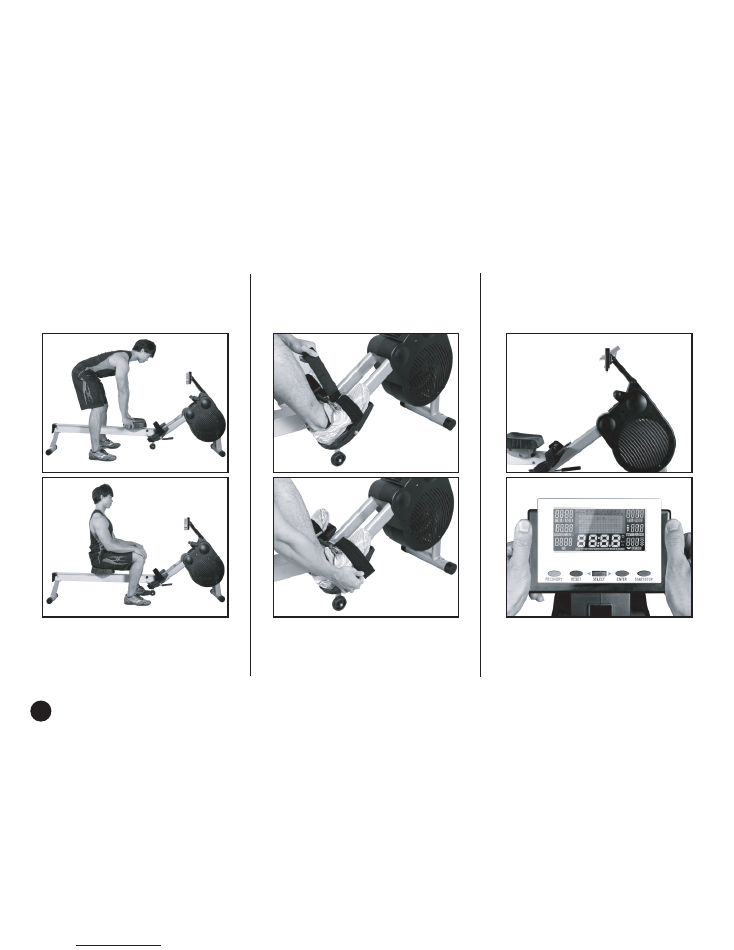
SETTING UP YOUR ROWER
Getting on Safely
Getting on safely is a simple procedure. Just be
careful that the SEAT is directly underneath you
before sitting down.
1. Straddle the ALUMINUM BEAM .
2. Correctly position the SEAT beneath you.
3. Sit down taking care that the SEAT has not
moved.
Computer Angle Adjustment
The COMPUTER is designed to rotate and
giving you angle adjustment.
NOTE: The rotation of the computer arm pivot has been
designed only for the packaging purpose, there is no
height adjustment function. The user can only adjust the
computer arm pivot to the designed position as shown
on the below diagram.
Hold the COMPUTER with both hands as shown
in the diagram above. Rotate and pivot the COM-
PUTER to the desired angle.
Foot Strap Release & Adjustment
The foot pedals are equipped with quick releas-
ing foot strap that are easy to adjust. The foot
pedals also pivot to allow the feet to move with
rowing.
Loosen the Velcro straps and adjust your feet
accordingly. Pull on the strap to tighten the strap
around your feet. Secure the Velcro down as
shown in the diagram above.
8
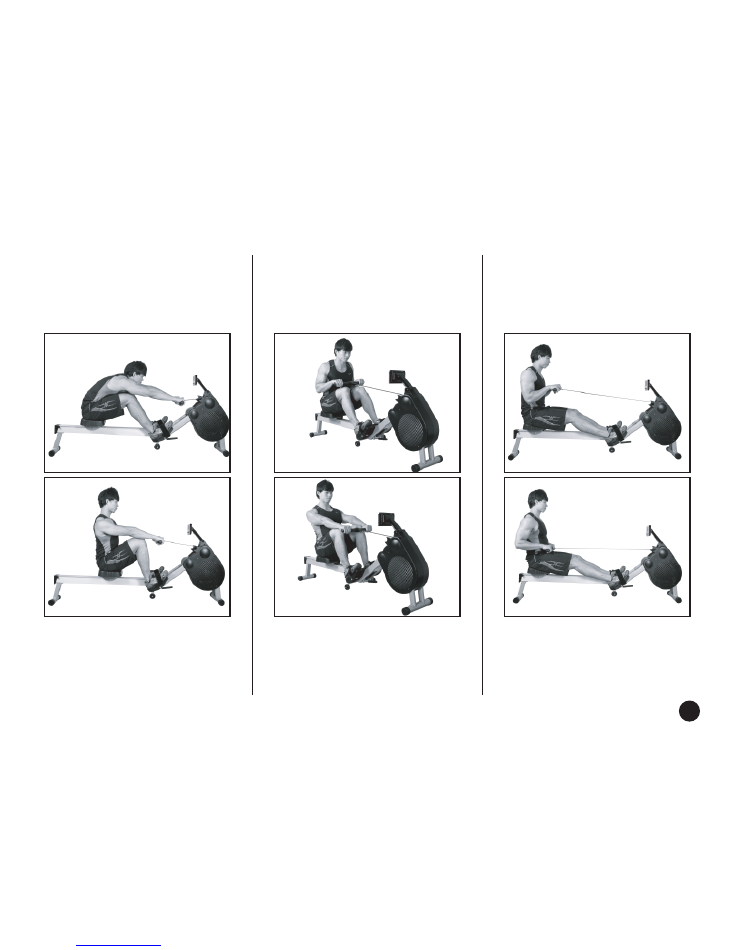
CORRECT ROWING GUIDE
Over Reaching
INCORRECT
The body stretches too far forward. The shins
may be past vertical. The head and shoulders
tend to drop towards the feet. The body is in a
weak position for the stroke.
SOLUTION
The shins are vertical. The body is pressed up to
the legs. The arms are fully extended and
relaxed, body tilted slightly forward. This position
should feel comfortable.
Rowing with Arms Bent
INCORRECT
The user starts the stroke by pulling with the
arms rather than pushing with the legs.
SOLUTION
The user starts the stroke by pushing the legs
and bracing the back with the arms fully
extended and relaxed.
Bent Wrists
INCORRECT
The user bends their wrists at any time through
the stroke.
SOLUTION
Always row with flat wrists through the entire
stroke.
9
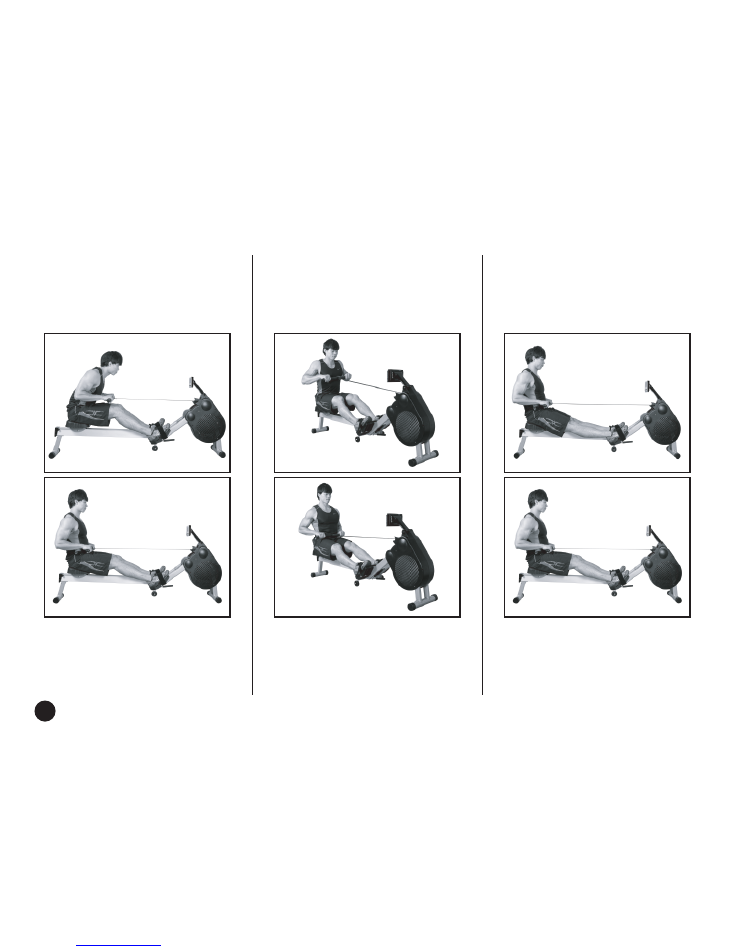
CORRECT ROWING GUIDE
Pulling the Body to the Handle
INCORRECT
At the finish, the user, instead of pulling the
handle to the body, pulls themselves forward to
the handle.
CORRECT
At the finish the user leans back slightly, holds
the legs down and draws the handle to the body
using the upper body as a firm platform.
Flying Elbows
INCORRECT
The users elbows are sticking out from the body
at the finish and the handle is at chest level.
CORRECT
Draw the handle to the body. The wrists are flat
and the elbows pass close to the body. Elbows
extend behind the body as the handle is drawn to
the waist.
Locking the Knees
INCORRECT
At the end of the stroke the user locks the knees
making the legs straight.
CORRECT
Always keep the legs slightly bend in the fully
extended position..do not lock the knees.
10

STRETCHING
Stretching should be included in both your warm
up and cool down, and should be performed after
3-5 minutes of low intensity aerobic activity or
calisthenic type exercise. Movements should be
performed slowly and smoothly, with no bouncing
or jerking. Move into the stretch until slight
tension, not pain, is felt in the muscle and hold for
20-30 seconds. Breathing should be slow, rhyth-
mical and under control, making sure never to
hold your breath.
1. Quadriceps Stretch
Reach behind body with
one hand, grasp top of
foot and pull heel toward
buttocks while maintaining
an erect and upright
posture. Hold for 20-30
seconds and release.
Repeat for opposite leg.
3.Back Stretch
With arms extended and
hips directly over feet,
lower upper body below
hand level by bending at
the knees. Hold for 20-30
seconds and release.
6.Buttocks,Hips,
Abdominal Stretch
While keeping both shoul-
ders in contact With the
ground, gently pull knee
toward the ground. Hold
for 20-30 seconds and
release. Repeat for oppo-
site side.
7.Inner Thigh Stretch
With soles of feet together,
lean forward from the waist
while applying downward
pressure to the inside of
the knees. Hold for 20-30
seconds and release.
8.Chest, Shoulder,
Upper Arm Stretch
Move buttocks forward
away from arms while
keeping arms extended
back and palms on
ground. Hold for 20-30
seconds and release.
4.Rear Upper Arm
Stretch
Grasp elbow and pull hand
toward midline of the body
while maintaining an erect
and upright posture. Hold
for 20-30 seconds. Repeat
for opposite leg.
5.Hamstring, Lower
Back Stretch
Holding thigh against
upper body, extend leg
toward ceiling. Hold for
20-30 seconds. Repeat for
opposite leg.
2. Calf, Achilles Stretch
Keeping back leg straight
and foot flat on floor with
toes pointed straight
ahead, move hips forward
by bending knee on the
front leg. Hold for 20-30
seconds and release.
Repeat for opposite leg.
1
11

Aerobic Fitness
The largest amount of oxygen that you can use per
minute during exercise is called your
maximum
oxygen uptake
(MVO2). This is often refered to as
your
aerobic capacity.
The effort that you can exert over a prolonged period
of time is limited by your ability to deliver oxygen to
the working muscles. Regular vigorous exercise
produces a training effect that can 30%. An
increased Mov2 indicates an increased ability of the
heart to pump blood, of the lungs to ventilate oxygen
and of the muscles to take up oxygen.
Anaerobic Training
This means “without oxygen” and is the output of
energy when the oxygen supply is insufficient to
meet the body’s long-term energy demands. (For
example, 100-meter sprint).
The Training Threshold
This is the minimum level of exercise, which is
required to produce significant improvements in any
physical fitness parameter.
Progression
As you become fitter, a higher intensity of exercise is
required to create an overload and therefore
provides continued improvement.
Overload
This is where you exercise at a level above that
which can be carried out comfortably. The intensity,
duration and frequency of exercise should be above
the training threshold and should be gradually
increased as the body adapts to the increasing
demands. As your fitness level improves, so the
training threshold should be raised. Working through
your program and gradually increasing the overload
factor is important.
Specificity
Different forms of exercise produce different results.
The type of exercise that is carried out is specific
both to the muscle groups being used and to the
energy source involved. There is little transfer of the
effects of exercise, e.g. from strength training to
cardiovascular fitness. That is why it is important to
have an exercise program tailored to your specific
needs.
Reversibility
If you stop exercising or do not do your program
often enough, you will lose the benefits you have
gained. Regular workouts are the key to success.
Warm Up
Every exercise program should start with a warm up
where the body is prepared for the effort to come. It
should be gentle and preferably use the Stretching
should be included in both your warm up and cool
down, and should be performed after 3~5 minutes
of low intensity aerobic activity or callisthenic type
exercise.
Warm Down or Cool Down
This involves a gradual decrease in the intensity of
the exercise session. Following exercise, a large
supply of blood remains in the working muscles. If it
is not returned promptly to the central circulation,
pooling of blood may occur in the muscles.
Heart Rate
As you exercise, so the rate at which your heart beat
also increases. This is often used as a measure of
the required intensity of exercise. You need to exer-
cise hard enough to condition your circulatory
system, and increase your heart rate, but not
enough to strain your heart.
Your initial level of fitness is important in developing
an exercise program for you. If you are starting off,
you can get a good training effect with a heart rate of
110-120 beats per minute (BPM). If you are fitter,
you will need a higher threshold of stimulation.
To begin with, you should exercise at a level that
elevates your heart rate to about 65 to 70% of your
maximum heart rate. If you find this is too easy, you
may want to increase it, but it is better to lean on the
conservative side.
As a rule of thumb, the maximum heart rate is 220
BPM minus your age. As you increase in age, so
your heart, like other muscles, loses some of its
efficiency. Some of its nature loss is won back as
fitness improves.
The following table is a quide for those who are
“starting fitness”.
Age
Target Heart Rate
10 Second
Count
Beats per
Minute
5

Age
Target Heart Rate
10 Second
Count
Beats per
Minute
Pulse Count
The pulse count (on your wrist or carotid artery in the
neck, taken with two index fingers) is done for ten
seconds, taken a few seconds after you stop exercis-
ing. This is for two reasons: (a) 10 seconds is long
enough for accuracy, (b) the pulse count is to
approximate your BMP rate at the time you are exer-
cising. Since heart rate slows as you recover, a
longer count isn’t as accurate.
The target is not a magic number, but a general
guide. If you are above average fitness, you may
work quite comfortably a little above that suggested
for your age group.
The following table is a guide to those who are keep-
ing fit. Here we are working at about 80% of maxi-
mum.
Don’t push yourself too hard to reach the figures on
this table. It can be very uncomfortable if you overdo
it. Let it happen naturally as you work through your
program. Remember, the target is a guide, not a rule,
a little above or below is just fine.
Two final comments: (1) don’t be concerned with day
to day variations in your pulse rate, being under pres-
sure or not enough sleep can affect it; (2) your pulse
rate is a guide, don’t become a slave to it.
Endurance Circuit Training
Cardiovascular endurance, muscle strength, flexibil-
ity and coordination are all necessary for maximum
fitness. The principle behind circuit training is to give
a person all the essentials at one time by going
through your exercise program moving as fast as
possible between each exercise. This increases the
heart rate and sustains it, which circuit training effect
until you have reached an advantaged program
stage.
Periodization
This is the term used to vary your exercise program
for both physiological and psychological benefits. In
your overall program, you should vary the workload,
frequency and intensity. The body responds better to
variety and so do you. In addition, when you feel
yourself getting “stale”, bring in periods of lighter
exercise to allow the body to recuperate and restore
its reserves. You will enjoy your program more and
feel better for it.
Muscle Soreness
For the first week or so, this may be the only indica-
tion you have that you are on exercise program. This,
of course, does depend on your overall fitness level.
A confirmation that you are on the correct program is
a very slight soreness in most major muscle groups.
This is quite normal and will disappear in a matter of
days.
If you experience major discomfort, you may be on a
program that is too advanced or you have increased
your program too rapidly.
If you experience PAIN during or after exercise, your
body is telling you something. Stop exercising and
consult your doctor.
6

DUAL MODE ROWER WARRANTY
The manufacturer warrants that its products are free of defects in workmanship and
materials, and will repair or replace defective parts, free of charge, for a period of
one year from the date of purchase.
This warranty is valid only in accordance with the following conditions:
1.This warranty applies to the DUAL MODE ROWER product only while the products
remain in the possession of the original purchaser and proof of purchase is
demonstrated.
2.This warranty applies to residential use only (unless specifically stated by the
manufacturer to be warranted for institutional use) and is void when used in a
non-residential environment.
3.This warranty excludes misuse, abuse, alteration, improper service, or on DUAL
MODE ROWER product modifications.
4.This warranty is in lieu of all warranties, expressed or implied, and/or all other
obligations or liabilities on the part of the manufacturer, and we neither assume
nor authorize any person to assume for us any other obligation or liability in
connection with the sale of this product, Under no circum-stances shall the
manufacturer be liable by virtue of this warranty or otherwise for damage to any
person or property whatsoever for any special , indirect, incidental, secondary or
consequential damage of any nature whatsoever arising out of the use or inability
to use this product